Don't Judge a Book by its Cover

This book goes through the events of the protagonist finding "little bit scary people" but then stating "but I bet..." and then saying something positive about them. It teaches not to judge a book by its cover. I would honestly read this book to any grade- even high schoolers. There are so many different activities you could do with this book, most of them teaching students soft skills and manners. But I believe you can take this book to a whole other level. You can incorporate this into a science lesson by having students predict what is going to happen and then recording what actually happens. Another idea would be to read this book as an introduction to a new lesson or study in E/LA. I have seen on pinterest where teachers will wrap a book in paper so that students can't see the title. That is then the book they have to read for that particular study. It would also be a great way to split students up into book club books. Or, if you want to teach critical thinking, students can be given those mathematical optical illusions where something appears one way but is actually another. This would help segue into a geometry lesson. I would probably use this book as a fun introduction to another lesson, but you could do a writing prompt if you wanted to focus solely on this book.
A.R. Reading Level: 3.8
So Many Opportunities!

When my children's lit professor assigned this book, I was not thrilled. I don't want to read a book about a boy who was raised by ghosts. That sort of story doesn't appeal to me at all, but I found myself staying up until 1am trying to finish it. This is a well written story about a boy whose parents are killed when he is a baby and then he ends up getting raised by ghosts, a vampire, and a werewolf. Despite the spooky theme of the book, it actually teaches extremely good lessons. Bod, the protagonist, grows up and becomes his own throughout the story. He learns how to read and write by tracing/rubbing letters on gravestones, he learns about history by the dead people who lived through it, but most importantly, he yearns to learn more. What Bod really wants to do is read and learn as much as he can. This book shows how important education is in a totally different way than most people imagine. I would use The Graveyard Book with upper elementary- no younger than 5th grade- for many reasons. When teaching this book in the classroom, there are obvious lessons you can teach such as figurative language, references, writing styles, etc. But there is so much content that can go beyond that. You could use this to teach about European history (or any history for that matter), early American history, the human body (science), geography, and many others.
If I were teaching this, one of the activities I would do would be to have the students pick out a prefabricated name and birth/death date out of separate piles. I would then have the students do heavy research on that time period (I could give a location if necessary such as the US). They would then write a fictional story about their character and give the character an inscription on a headstone that they would draw.
Lexile: 820L
Grade Equivalent: 5.4
Wonderful website I found full of The Graveyard Book resources:
https://sites.google.com/site/theghoulgate/home
Little READ This Book!

"Little Red Writing" surpassed all of my expectations. I expected it to be a simple story about little red riding hood except the girl is now a pencil. I was very wrong. This book teaches while entertaining! It goes through the writing process, details many different parts of speech, and talks about punctuation. I would use this in an upper grade classroom by reading it aloud to the class before the students have to write a story or paper. It would remind them of grammar rules and sentence structure while letting their minds think about what they want to write. Just like in the book, I would give students 15 categorized words to use in their story. After reading the book aloud to the class, I would have the students come up with a 2 page story using those 15 words.
Lexile: AD 740L
Guided Reading: O
Grade Level Equivalent: 3.5
How to Solve Bullying

This lovely book is about a kid who doesn't like the new boy in town. He wants to make that kid's life miserable, so his dad tells him to make enemy pie. But in order for the enemy pie to work, the two boys have to "pretend" to be friends for an entire day. Of course the two boys end up being friends. This is a great book for the classroom for multiple reasons. I would use it to teach tolerance and bullying awareness. For an activity, I would use this as a fraction activity. Pie is a main theme of the book, so I would use slices of pie (fake pie) to teach fractions or even pie charts. http://youvegotthismath.com/2016/10/31/addingfractionspuzzles/
Age Range- 5-8 years
Lexile: 330L
Great STEM Activities!

Andrea Beaty, author of "Iggy Peck, Architect", "Rosie Revere, Engineer", and "Ada Twist, Scientist" (along with others) has written these great STEM books that I believe will inspire many kids (and adults)! This particular book is about a boy named "Iggy Peck" who loves constructing things out of all sorts of weird materials like diapers. His parents are weary and his teacher HATES architects, so Iggy feels defeated. But on a class trip, the whole class gets stuck on an island and can't get to the other side because the bridge had collapsed, so Iggy, with the help of his classmates, builds a bridge to save the day.
I would 100% use this in class for different types of math lessons! Here are some ideas:
1. Have the students go home and measure a room of their house (with the help of an adult). If they don't have a measuring tape at their house, you can let them measure the classroom instead.
2. Let the students design their dream house on graph paper. This could work on shapes, dimensions, length/width, measuring, and working with scale.
3. Have the students use Legos to design a bridge, house, or other structure.
ATOS Reading Level: 4.1
Lexile: AD 850L
Chrysanthemum's a Daisy!

This lovely Kevin Henkes book has been one of my favorites since I was a kid. I really connected to Chrysanthemum- even though I wasn't bullied because of my name, I did hate my own, wanted to be called "Lily", and mac & cheese was/is my favorite food just like the main character of the book. "Chrysanthemum" is a great book to use in the classroom because it talks about feelings, bullying, and being nice to people. Because this book is very well known, there are many resources available for it.
An activity that I have done in the past is this: I printed out large versions of positive (happy face, heart eyes, etc) and negative (crying, frowny face, etc) emojis and glued one of each to a popsicle stick- enough for each person in class. While the book is being read aloud to them, the students react using their emojis. This is great for younger grades, but can be adapted to older grades by having students fill out an anchor chart of positive/negative emotions that go further than the usual "happy" and "sad". The anchor chart can then be used during writing so that the students have a mini thesaurus to look at.
Guided Reading: L
Lexile: 460L
Scholastic Discussion Guide:
http://www.scholastic.com/browse/collateral.jsp?id=32395
Despite the Title, This Book is NOT Dull!

A humorous picture book titled "Meet the Dullards" caught my eye at the library, so of course I HAD to check it out. It was totally worth my time and is worth yours too. It tells the tale of the Dullards- a dull family that doesn't want anything even remotely "fun". The kids however, have a different attitude. It makes for a fun book that children think is funny and ridiculous. This book would be great for teaching kids soft skills and manners and that every family is different. I would use this book for a "First Week of School" activity so that I can get to know each student's family. After they do a work sheet/coloring sheet describing their families to me, I would have the students come up with a fake family that was different in some way- maybe they only eat soup or maybe they cook food in the bathroom? Then they would write about that family in a story. This activity would work on character development and story/creative writing.
Reading Level: 3.8
Lexile: AD 520L
A Masterpiece of a Book
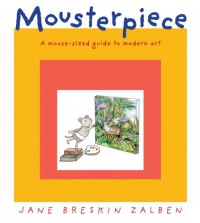
Art often gets left out of most in-classroom teaching, but I believe that "Mousterpiece" can help bridge that gap. The book is about a mouse who copies the styles of famous artists in her paintings. She is discovered and asked to display her artwork in a show. She realizes that her favorite painting is the one that was an "original" design, inspiring readers to create their own unique artwork. In the back of the book, there are facts about the famous artists and works of art featured in the book, which is a great resource for students and teachers. I would use this book as a companion/sidekick to another book or lesson. If the class was learning about a specific artist (and if "mousterpiece" had that artist in the book), I would use the book as a segway into the specific artist lesson. For a more adaptable lesson, I would read this book aloud to the class to keep the students inspired to create their own art and be true to themselves when doing any type of art activities in class.
Lexile: 540L
Grade Level Equivalent: 2.3
The Rope Swing Broke- And So Did My Heart

"Bridge to Terabithia" is a very sad book that confronts the realities of life in a way that really connects with kids. The book is about Jess and Leslie, two friends who create an imaginary land called Terabithia which they visit often. After Leslie dies in a tragic accident, Jess reflects back on his memories and is transformed in the rest of the book. Though this novel has much to offer in terms of literary devices- character development, vocabulary, symbolism, etc. But it also opens an array of other opportunities. Nature is a large part of the book as well as imagination and friendship. Because I am a big believer in STEM, I think this book would be a great opportunity to work on some STEM activities. There are many STEM lessons that involve designing bridges, building them, and testing their strength. Doing this activity would also focus on teamwork and cooperation. Overall, this book has many possibilities and I highly recommend it for any older classroom.
Guided Reading Level: T
Lexile: 810L
Grade Level Equivalent: 4.6
BFG- Best Fictional Gift

This well known book is a favorite of many- and I know why. Roald Dahl is an amazing author and his work really shows through this book. It tells the story of a young orphan named Sophie who meets the BFG- Big Friendly Giant. He is the only giant that isn't nasty or a children eater. Instead, he and Sophie come up with a plan to save future children from being eaten- by telling the Queen of England and having her lock the other mean giants up. This book is perfect for all sorts of activities in the classroom. A quick search of "BFG" on pinterest pulls up many fun activities that engage the children while allowing them to learn new things. One of the best ideas I saw was incorporating "The BFG" into STEM activities (https://www.teacherspayteachers.com/Product/The-BFG-by-Roald-Dahl-STEM-Challenge-2538071). Students are asked to dream up then construct a fork that the BFG could use to eat his food. This can be taken to the next level, though. Students could fictitiously design tools, utensils, and other important items for people with disabilities. Not only would this put their STEM minds to use, but would also get students to think about other people who don't necessarily have that easy of a life and that "simple" tasks can be hard for other people.
Guided Reading: U
Grade Level Equivalent: 5.8
Lexile: 720L
Another Cute Idea:
https://www.pinterest.com/pin/138345019782627706/
"Rules" Rules!!!
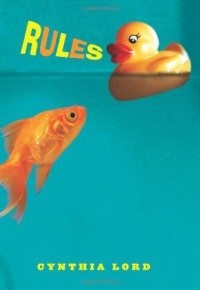
I have read "Rules" many times because I can't get enough of it. It is the story of a girl named Catherine who's brother has autism which she has to deal with on a daily basis. She meets a boy, Jason, who is in a wheelchair and speaks using picture cards. She quickly befriends him and learns so much about him and his disability. This book is absolutely fantastic for teaching students about different types of diversities and disabilities. I would love to have a class set of "Rules" so that the whole class can read it and go more in-depth with the text. There are suggested study/discussion questions in the back of the book as well as activities that would go along great with the book, which I would probably use. But most importantly, I would have an activity to go along with this book where the students go to the special needs room at the school and interact with the students there. Either that or have some of the students come to our classroom. I could let students come up with simple games or fun activities to do or we could simply read books to them. Either way, I would love for this book to be a way to introduce students to other people with disabilities and I know it has the potential to do so.
Guided Reading: R
Lexile: 780L
Suggested Grade: 4th
Hop on the "Magic School Bus" Fad
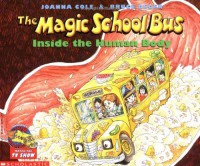
As with all "Magic School Bus" books, this one is clever, educational, and funny. Students will be engaged when reading. The school bus shrinks down and enters Arnold's body. The class explores the digestive system, circulatory system, and other systems of the body. I would use this book to introduce (or re-introduce) the human body systems and their functions. For an activity, I would have the students split into human body system groups. They would trace their body on a piece of white butcher paper and draw their specific system with a decent amount of accuracy (those with the skeletal system would draw bones inside the outline). I would hang them up in the hall for everyone to see. :)
A.R.- 4.6
Guided Reading- P
Lexile- AD 520L
Fantastic FOR Your Brain!
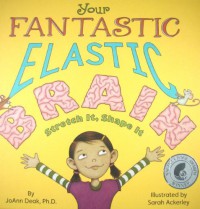
This clever book introduces the brain to children in a kid-friendly way. This book has many illustrations, comprehendible vocabulary, and lots of humor. The book is inspirational, teaching kids to try hard, practice, and never give up. During a study on the human body and/or brain, I would read this book aloud to the class but also have it available at a center so that students can read it again. Because the book details different parts of the brain, I would use that to my advantage and split up the class into groups- one group per part of the brain. I would have the students do quick research and present it to the class.
A.R.- 4.5
Lexile- 870L
Guided Reading- O
Recommended Grades: 2-4
This Book is One in a Million!


I had this book when I was younger but lost it. After going to the thrift store and finding it again, I realized just how educational it was. I used to read it just because I thought it was a funny book. The book talks about money- money conversions, what you can buy with certain amounts of money, interest, loans, checks, saving v. spending, and general fun facts about money. The visuals help children learn and the pictures are well drawn and fun. If it could interest 2nd grade me, I feel like it could interest almost any kid. This is probably a book that I would keep in the math section in my classroom so that students can read it without any pressure to do so. I would also incorporate it into any lesson about money. I have been thinking about a money project idea for a long time and think that this book would go along great with it. I would have students create a store that "sells" products. Each student would have a role in the fake economy. It would be a hands on project that I believe kids would love but it would also teach them about money (which is crucial to being an adult) in a fun way that I hope would stick with them in the future. Every teacher needs this book! You can even incorporate it in younger grades by just reading the first few pages that talk about pennies, nickels, dimes, quarters, and dollars.
A.R.- 4.1
Guided Reading- O
Lexile- AD 840L
It's the Bee's Knees!


This is a fantastic book! I stumbled upon the book when at the thrift store. It has 440 "animal sayings" that explain the figurative language of similes, metaphors, idioms, and proverbs that adults say. These type of sayings like "to play cat and mouse" and "catty remarks" are sometimes difficult for children to understand, so this book is great for learning phrases. I even learned some myself! The kid friendly way the book portrays the information (with humorous and telling illustrations) is very helpful and well thought out. I believe that this would be a perfect book for ELLs as well! I would use this in my class for a study on figurative language. Because this book only includes animal related figurative language, I would have the students find more sayings (between 1 and 10 based on grade level) and do illustrations for most of the sayings like it is done in the book. I would then bind the pages to make a class book. I would make sure that no student used the same saying as another. Overall, this is a fantastic book and I highly recommend it to any teacher!
Guided Reading: P
Recommended for: Grades 2-6
PhenomenELLIE

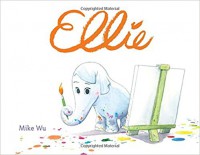
This lovely children's book is about an elephant who feels left out because she can't do all of the awesome things that they can do. But Ellie stays true to herself and learns that everyone is different. She discovers she is really good at painting, so she paints everything she sees. This is a beautifully illustrated and inspirational book. I would use this book with younger elementary students and have them try to paint something or at least create a piece of art in class. This would be something fun to do at the beginning of the school year. And at the end of the school year, the students could paint a friend (like Ellie did in the book). I would also have the students learn to sign their name in cursive just like Ellie does.
This is a book I would read out loud to the class.
Recommended Ages: 3-6
Guided Reading: K
Lexile Measure: AD560L




